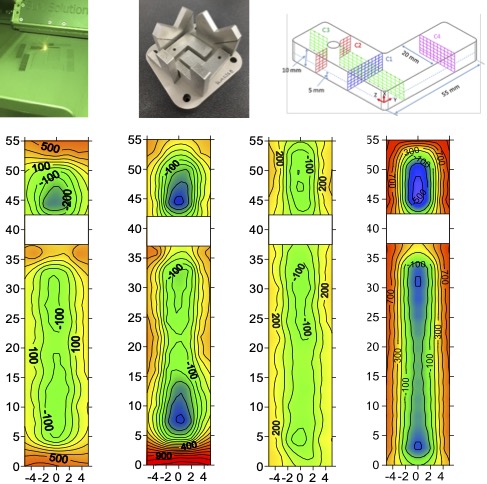Why?
In metal 3D powder bed printing, a part is built on a baseplate layer-by-layer through powder deposition and selectively melting of the deposited powder layer. The localized rapid heating and cooling cycles involved inevitably result in the development of residual stresses in the already solidified bulk of the part. The residual stresses can cause in-process failure by damaging the powder re-coater, rupturing the support structure, cracking the part being printed, etc. Residual stresses that are retained in the built part after it has been removed from the baseplate can impair the load bearing capacity of the part and/or cause part distortion. Therefore, understanding the evolution of residual stresses and the effect of the building process is important for optimizing the 3D printing process to ensure successful manufacturing of high-quality parts.
How?
Residual stresses in L-shaped parts of nickel-base superalloy manufactured by laser powder bed fusion (LPBF) (Fig. 1) were investigated using neutron diffraction. With the penetration power of neutrons, residual elastic strains were mapped non-destructively in the parts removed from the baseplate, from which residual stress distributions were derived. The impact of build orientation was revealed, see Fig. 1 for an example of stress mapping. In addition, a layer-by-layer finite element model for residual stress prediction was validated by the neutron diffraction experiment and used to elucidate the evolution of residual stress with progress of the printing process and also the removal of baseplate.

Fig. 1 Top row: Parts during printing (left), parts built in vertical, 45o, and horizontal orientations (middle), and cross-sections (C1 to C4) for neutron diffraction mapping (right). Lower row (from left to right): measured residual stress distributions in C3 for printing in vertical, 45o, and horizontal orientation, respectively and the prediction for C3 in 45o part. Stress values in the contour maps are in MPa.
What´s next?
The use of varying laser scan strategy for printing to mitigate the level of tensile residual stresses will be investigated by both neutron experiment and modelling. In addition, the effect of the residual stress on fatigue performance will be studied by combining neutron diffraction experiment for residual stress mapping and fatigue testing.
Who?
The work is carried out through a SwedNeSS PhD student project at the Department of Management and Engineering at Linköping University, with contributions from RISE IVF in Sweden and ANSTO in Australia. The experiment was performed in ANSTO (KOWARI stress diffractomer).
For the original articles, please visit:
- Pant, S. Proper, V. Luzin, S. Sjöström, K. Simonsson, J. Moverare, S. Hosseini, V. Pacheco, R. L. Peng. Mapping of residual stresses in as-built Inconel 718 fabricated by laser powder bed fusion: A neutron diffraction study of build orientation influence on residual stresses. Additive Manufacturing, (2020) 36, art. no. 101501. DOI: 10.1016/j.addma.2020.101501
- Pant, S. Sjöström, K. Simonsson, J. Moverare, S. Proper, S. Hosseini, V. Luzin, R. Peng. A simplified layer-by-layer model for prediction of residual stress distribution in additively manufactured parts. Metals (2021), 11 (6), art. no. 861. DOI: 10.3390/met11060861
Contact:
Prof. Ru Peng
Linköping University
Prof. Vladimir Luzin
ANSTO
